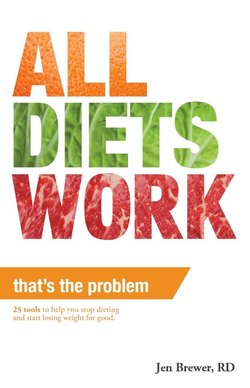Читать книгу All Diets Work, That's the Problem! - Jen Sr. Brewer - Страница 9
На сайте Литреса книга снята с продажи.
Principle 4: Exercise
ОглавлениеOur bodies were created to work. In our modern society, we are constantly looking for ways to get around this simple principle of work. We have convenienced and automated ourselves into obesity.
The principle of exercise is very basic: you’ve got to move it to lose it.
Here is a simple scenario: as discussed in Principle 1, it takes a deficit of 3,500 calories to lose one pound. To reach that goal in a week, you would need to cut back on 500 calories every day. To lose two pounds, you’d have to cut 1,000 calories every day. That’s a lot of calories to cut.
However, if you add exercise, you can alter the amount of calories you need to cut, or, even better, you might not have to cut any calories at all. Sixty minutes of walking (at 3.5 mph) for a 200-pound person burns 346 calories, so if you did this activity six days a week, you would burn 2,422 calories. That would allow you to meet your goal of losing one pound a week with a cutback of only 154 calories a day. If you want to go for two pounds, you’d have to cut your calories by 654 per day.45 That’s a big difference, just by adding exercise.
There are two main types of exercise: aerobic (also called cardio) and anaerobic (sometimes called resistance training). Aerobic exercise is anything that is continuous in nature and consists of moving the same muscle groups for a prolonged period of time (at least 10 minutes). Examples of aerobic exercise include walking, jogging, swimming, and biking.
Anaerobic exercise (resistance or strength training) uses the muscles to work against a resistive load (usually weights, bands, medicine balls, etc.).
The body needs both forms of exercise throughout the week. The current recommendations say that we should aim for at least 60 minutes of exercise every day of the week. Of those bouts of exercise, two to three sessions should be resistance training (preferably alternating the days with cardio), and the rest should be aerobic activity. With resistance training, it’s best to lift muscle groups that oppose each other in the same session. For example biceps (front of upper arms) and triceps (back of upper arms), pectoralis (chest) and trapezius (upper back), deltoids (shoulders) and latissimus dorsi (lats) (middle back), abductors and adductors (inner and outer thighs), and quadriceps (front of leg) and hamstrings (back of leg).
One of the biggest complaints I receive from patients regarding exercise is, “I don’t have time to exercise.” And they are right. We don’t have time to exercise. We have to make time to exercise. If you can’t find a continuous 60 minutes, you can exercise in smaller sessions throughout the day, provided those sessions increase the heart rate enough to give one the benefits of exercise. In studies, people who exercised for ten-minute mini-sessions throughout the day saw the same benefits as those who did the full amount of exercise at once.62,63 See Tool 20: Schedule Exercise for more information on exercise.
Exercise not only aids in weight loss and maintenance, it also helps in myriad ways to improve the health of the body, including:18,19, 23, 46-61
Health Benefits of Exercise
•Increases flexibility
•Increases strength
•Increases blood supply to muscles and organs
•Increases HDL cholesterol (the good type of cholesterol)
•Builds and maintains healthy muscles, bones, and joints
•Improves psychological well-being
•Enhances work, recreation, and sport performance
•Improves glucose tolerance and reduces insulin resistance
•Reduces risk of heart disease
•Reduces high blood pressure or risk of developing it
•Reduces high cholesterol or risk of developing it
•Reduces risk of developing certain types of cancer
•Reduces risk of developing diabetes
•Reduces depression and anxiety
•Decreases triglycerides
•Lowers heart rate
•Reduces risk of premature death
•Decreases blood-sugar levels (great for blood-glucose control in patients with diabetes)
